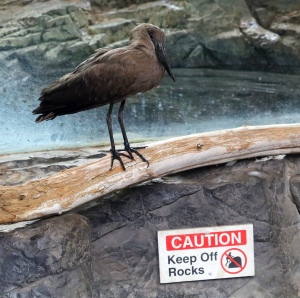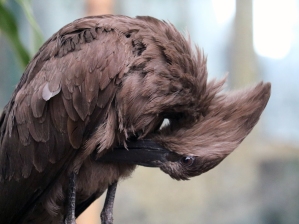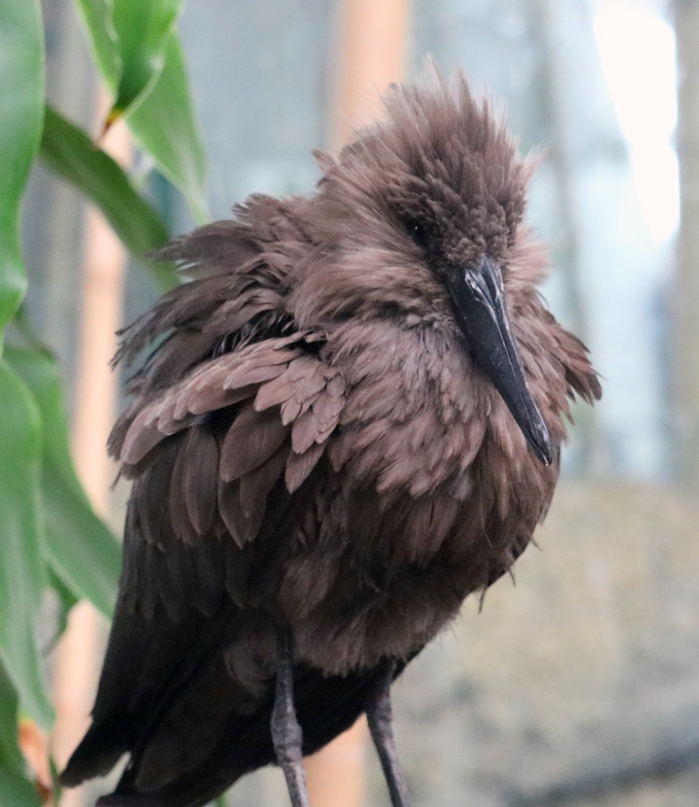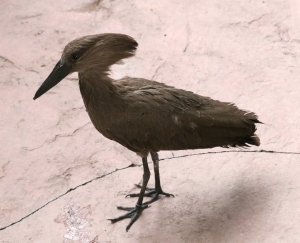
Such a handsome bird!!

Can Homer read English??
In the African Rainforest Pavilion of the Toronto Zoo there lives a handsome young man who is kind of a “hidden gem:” a hamerkop named “Homer.” (Truth be told, there is a second hamerkop who is harder to see; I’ll get to him a bit later.) He makes his home in an open-fly aviary which is situated halfway between the two prime viewing areas for the western lowland gorillas (spoiler alert: they appear later in the calendar), and visitors passing through the area are usually captivated by the otters in their large tank, or are rushing through to get to the other end of the pavilion where the baby pygmy hippo dwells (spoiler alert 2: also featured later in this calendar). Add to this his dark colour (which camouflages perfectly in this area as well as his natural environment) and the fact that he spends much of his time either backlit by the sun, fussing with his enormous nest, or sitting high up in the rafters, and Zoo attendees may be excused for not even realizing he’s there at all. But if you’re passing through that aviary, do stop and make the time to try to find him. He’s quite a magnificent sight once you spot him.

Everything is “nest-worthy” to Homer!
About that nest: it truly is a wonder to behold. Homer spends an incredible amount of time building, repairing, rebuilding, and just generally fussing over it. And nothing that hits the floor in that aviary is without consideration as a potential building material: have a look at this photo and you’ll see what I mean! If you drop an article of clothing, or a Zoo map, or a $20 bill, or really anything at all, you had better be very quick to notice and react. Homer will come swooping in out of nowhere, buzz right over your head, land on the floor, snatch the new treasure, and bring it back to his nest to be woven into place. I can neither confirm nor deny that I may have used this to my advantage in getting Homer into good range for a photo by lightly tossing a glove or lens cap a foot or two in the air after calling his name, causing him to fly down and land on a branch nearby. (That’s such a detailed story that I feel confident you can work out whether it’s true or not.)

Enrichment on the wing
Most of the time, however, I just have to call out his name to get his attention, because he’s a precocious and very sociable bird. Sometimes he’s already close at hand, as was the case on a day last November when I took the photo here. He was having a great time bouncing about on that branch, seemingly oblivious to how much entertainment he was providing to the otters on the other side of the glass, but likely knowing exactly what he was doing all along. I spent a great deal of time with him that morning; in fact, I had brought in a couple of the 2018 calendars for a Volunteer who was working in the pavilion and I showed Homer his photo. Luckily I have her as a witness for what I’m about to type; otherwise, I wouldn’t fault you for doubting it. When I called Homer and held the photo up for him to see, he was very interested in it, cocking his head back and forth and stretching out his neck to get a better look. I don’t imagine he knew it was a photo of him, but I would think he would recognize his own species when he sees it. That was quite a bit of fun!
I have only very recently (late last year) discovered that there is actually a second hamerkop in the African Rainforest Pavilion. His name is “Herman,” and I believe he actually has been there longer than Homer has. He doesn’t live in the aviary, but in the large bird enclosure that is visible across the radiated tortoise exhibit opposite the pygmy hippos. And about a week after a Keeper pointed him out to me, busily building a spectacular nest of his own, the Zoo posted a video of him and his creation:

A good view of Homer’s “hammerhead”
“Hamerkop” means “hammerhead” in Afrikaans. Take a look at the photo at left for a good view of the back of Homer’s head and you will have a pretty good idea of how this species got its name. It’s funny: I never really thought of myself as a “bird guy” before I began to spend so much time at the Toronto Zoo, but it’s incredible how many different winged creatures who live there I have become extremely fond of. Having spent so much time just watching Homer in his aviary, I can honestly say that he is a supremely handsome fellow if you get to see him in person: there are so many subtly different shades of brown in his feathers that you never really see him the same way twice. It’s especially fun when you can catch him mid-preen and that beautiful plumage is sticking out all over the place:

Quite a “do” for my handsome young lad

Showing off the entire “hammerhead”
There is a breeding pair at the Calgary Zoo and I believe they had some chicks last fall. It would be pretty awesome if one of those chicks turned out to be a female and was sent to Toronto to partner up with Homer. He has spent an awful lot of time fixing up that nest and I would love to see him share it with a mate! In fact, I believe that it was hoped that Homer would turn out to be female – and, therefore, a mate for Herman – when he first arrived, but it was not to be. It’s not that easy to sex birds at a young age – take a look at the names of the penguins at the Toronto Zoo for confirmation of just how hard it is – so it could be a while before there is any more concrete information coming out of Calgary. But Homer’s waited a long time as it is; what’s another few months, more or less?
I think it’s time to wrap this up because Homer is sitting on his nest giving me the side-eye and I’m concerned he might try to grab something from my… LOOK OUT! INCOMING!!!

DUCK! (Actually, it’s not a duck, it’s a hamerkop…)
That’s it for February – thanks for stopping by! Next month, though… oh boy, do not miss it. It’s one of the very best photos I took all of last year. Hint: I referred to it earlier in this post. See you then!



Steve! Magnificent post. I must admit, I don’t remember seeing this handsome lad because of my love of the otters which get my full attention. Next visit for sure!
LikeLiked by 1 person